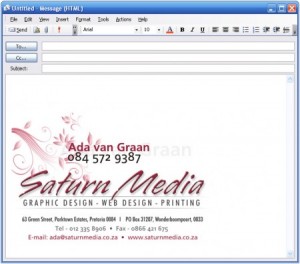Posts tagged e-marketing

Marketing Tips For Your Email Signature
Email signatures are so commonplace, and in most cases, boring, that they are usually an afterthought to most. But they don’t have to be, and they can actually help you achieve your marketing and sales goals. I should quickly make note that when I say “email signature”, we are only talking about person-to-person emails, not the footer, etc. used on your email marketing or e-newsletter campaigns.
And make note that these tips don’t just apply to your own email signature. These strategies also work for your employees, your co-workers or team members, especially if they are sending out customer service or sales-related emails.
First the basics, those standard pieces of information that simply have to be part of your signature and those representing your business:
•Name, company name, address and phone number
•Twitter and Facebook links and encouragement for people to follow you
•Website and blog address
Then there are some more creative ways you can utilize the signature portion of your emails that aren’t necessary but could help you add to your social media connections, website visitors, and increase your sales:
•Your logo
•A “Deal of the Week” with a special link so you can track how it’s doing
•A link to “Join Our Monthly/Weekly Email Newsletter” and receive special email-only offers
•A customer testimonial so that your recipients can see how much your customers love you
•A link to a webinar or an event you want them to attend
So don’t let your email signatures be an afterthought!
And if you’re going to have a weekly deal, make sure you follow through and change your deal weekly. Some people might even begin to look for it.

Newsletters – Print or Email?

As the economic recovery shuffles along – and “shuffle” seems to be the right word, companies and small business owners continue to look for ways to promote their products, services and brands in the most cost-efficient way.
And most understand that a newsletter can be one of the most powerful ways to build lasting relationships with their customers. But which deliver medium should they choose, email or print?
Both varieties share informative articles, customer resources, special offers and discounts. And either format requires a writer, a designer (at least once), and a mailing list.
E-newsletters have become so popular because they are a lot cheaper to distribute; can be sent more frequently; and can reflect up-to-the-minute price changes or offers. But they can be easier to ignore or delete, or blocked all together. And you also need to have – or begin building – an email list to distribute the piece. Sending unwanted spam to recipients is not acceptable to most legitimate businesses.
Print newsletters on the other hand usually have higher readership numbers and response rates, if only because the recipient is forced to view the publication, at least for a moment (perhaps on the way from the mailbox to the trashcan!) But this is often more than offset by their much higher costs.
Printing a newsletter means spending money on paper stock, the printing process itself, handling costs and finally the expense of postage. You may also need to purchase or “rent” a mailing list, an additional expense.
And all but the most simple of printed newsletters still need the attention of a graphic designer to “lay out” the copy and artwork, and get the document prepared and sent to the printer. Most e-newsletters can be sent without this expense.
But some publications are simply better as physical pieces of collateral. Newsletters that also serve as catalogs are one good example. And a printed publication has more “weight” in the minds of some consumers, especially for brand new businesses.
So which is better? For some companies, the answer is both. Since the delivery mediums are so different and have their own unique virtues, sending a periodic e-newsletter, along with a less frequent printed newsletter, can be a good strategy. And some publications simple work better as a more permanent, and portable, reference material, such as a yearly catalog.
When you harness the power of both e-mail and print newsletters in tandem, you can boost brand recognition, and revenues.
Need help writing your next print or email newsletter? Or maybe need some assistance in developing a brand new publication? Give us a call or send us an email and we’ll be happy to discuss your options.

Open Rates

There different ways to measure the success of your email marketing or E-newsletter, but the most common and easiest understood metric is the Open Rate. Makes sense. If folks don’t open your message, they can’t be influenced by it!
But what about the simple brand awareness/recognition that you achieve by recipients simply seeing your piece in their inbox? (see, it’s complicated…)
So your open rate is obviously of supreme importance over the long term. It’s the first step towards “conversion”, whatever that may mean to you, and marketing success.
It is also fairly clear that you’ll never achieve a 100% rate, or anything close. Everyone’s time is too short and inbox too full for that to happen. But you shouldn’t spend much time worrying about the specific open rate, anyway. (What?? I thought you said it was vitally important a second ago? Bear with me for a moment.)
The reason the actual number is of limited significance is this: What constitutes a “good” rate? In comparison to what?
There are many different types of communications, both business-to-consumer and business-to-business. Business-oriented lists tend to have higher rates, partly because emails seen in the preview pane of Outlook (a common business email service) count as “opened”. Everyone has a different list profile, too.
If you send to a rented list of 100,000 people, and 10% (or 10,000) view your piece, that could be a smashing success. If however you send to your own personal house list of 50 addresses, and only 10 view your email (20%), you might consider this a failure!
What matters most is when or how your open rate changes from campaign to campaign. An increasing rate says you’re hitting the mark, a decreasing open rate points to a problem.
That said, there are certainly some tricks and tips that our writers have learned to improve open rates over time. We’ll share some of these in future posts to help you improve your rates, too!

